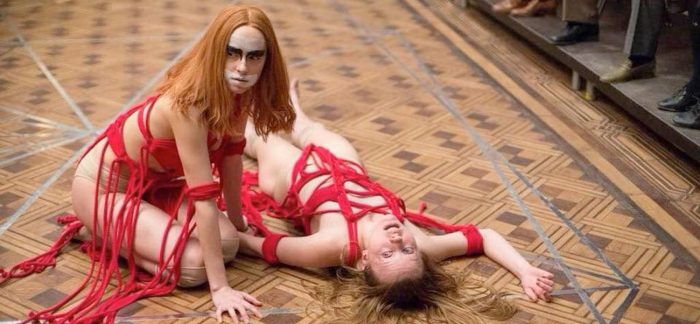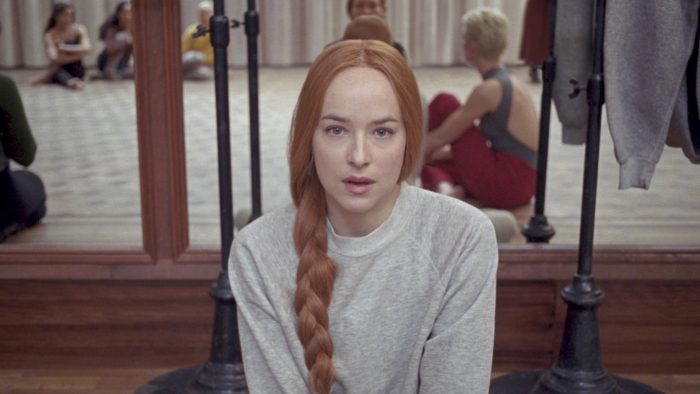
After playing the Venice Film Festival, the first reviews from the anticipated horror remake Suspiria have rolled in, and just as the trailers seemed to indicate. this is bound to be the most divisive film of the year.
Dakota Johnson stars in the film as a young woman names Susie, raised by Mennonites, who has been longing to dance with Berlin’s Helena Markos Dance Company. As Susie digs into her passion for dance, she becomes embroiled in darkness and mystery as she discovers that this dance group is controlled by a coven of witches. This movie has the potential for chills and thrills, but as the critics point out, director Luca Guadagnino (Call Me By Your Name) has opted for something less scary in favor of something more cerebral and unsettling, bringing high art to horror in a way that will frustrate the average genre fan.
It sounds like Owen Gleiberman at Variety was hoping for something a little less artistic:
“Suspiria” is that rarity, an extreme horror movie made by a deeply serious maestro of a director. Yet considering that it’s a remake of one of the most lavishly nutty baroque-schlock horror films of its era, you’d think Guadagnino might have wanted to lighten up and take a bit more debauched glee in the material. But no. He has said that while he grew up as a fan of Dario Argento’s “Suspiria,” which he saw for the first time when he was 14, he has chosen to reimagine it in the style of a film by Rainer Werner Fassbinder.
He isn’t kidding. The new “Suspiria” has more than touch of Fassbinder’s astringent dryness and rigor, and a little of that goes a long way. The movie, while absorbingly crafted, is two-and-a-half hours of solemn slow-burn mystery. It makes you wonder what’s coming next — a remake of “The Hills Have Eyes” done in the style of Chantal Akerman? Hirokazu Kore-eda’s reboot of “Audition”? “Suspiria” has the virtues, but also the limits, of a lavishly cerebral high-end horror film. It holds your attention, and creeps you out at times, but it’s not scary, and it’s not really — dare I say it? — fun. By the time it drags itself to the finish line, you may think, “Okay, now we know what ‘Suspiria’ looks like as an art film. Can we please go back to when it was just a garishly flamboyant piece of bat-house trash?”
Stephanie Zacharek at TIME was not impressed by the proceedings. She calls it “bland, grisly, boring and silly” and also writes:
“It could all be OK, maybe, if Guadagnino, cinematographer Sayombhu Mukdeeprom and production designer Inbal Weinberg had chosen a more vibrant color palette: While it’s their right to rethink Argento’s vision as they like, does anyone really want to see a beige Suspiria? On the plus side, the music, by Radiohead’s Thom Yorke, is suitably chilly and sonorous, and the costumes are rather grand: Giulia Piersanti gets the late-1970s Eyes of Laura Mars thing down perfectly, putting the cast in lots of tall boots, belted coats and billowy tunic dresses, with the occasional swirling cape. There are some nice kimonos—good for running to and fro between secret rooms—and Swinton, in one of the two roles she has here (one should be left a surprise) has a superb wardrobe of floor-sweeping monastic black jersey dresses. Of course, she looks great in everything, and watching her is never dull. She’s a witch with a pulse. But not even her powers are enough to reanimate the gray corpse of this Suspiria.”
Tim Grierson at ScreenDaily finds the ambition more admirable than the final product:
“A sensuous experience designed to provoke — whether it be rapture, outrage or eye-rolls — Luca Guadagnino’s remake of Suspiria is a feast of excess, carrying with it all that’s both enticing and frustrating about such a strategy.
Almost an hour longer than Dario Argento’s original — but equally unapologetic about swerving between psychological horror and high melodrama — the film demands the viewer’s indulgence, repaying that patience with a story that can be rhapsodic in its tonal command but also cheekily campy. Ultimately, though, Suspiria’s inconsistencies, flashes of brilliance and irritating pretensions all feel part of the same package. Like the movie’s avant-garde dance numbers, Suspiria reaches for greatness, and the whirlwind of that effort is sometimes more stunning than the execution.”
Glenn Kenny at RogerEbert.com wrote up a brief round-up of some movies he caught at Venice, and for Suspiria, he wrote:
“What makes it repellent is the hifalutin brand of misogyny it (relentlessly) soft-pedals, and the deliberately excessive horror imagery it throws up with giggly glee. Whatever you think of Argento’s “Suspiria,” or his work overall, you have to admit that his morbid sadism appears to arise from an authentic impulse.
For Guadagnino, simulated carnage is just another app. I’m racking my brain to find another example of an instance in which a director used his complete artistic freedom for the purpose of flaunting his absolute lack of artistic conviction. And I’m not coming up with much.”
David Rooney at The Hollywood Reporter says the movie is bound to be polarizing:
“Luca Guadagnino’s elaborate Suspiria remake is a head-scratcher. Following his intoxicating plunge into the giddy pleasure and searing pain of first love, Call Me By Your Name, the Italian director makes a sharp left turn to reinterpret a signature work by Dario Argento, a compatriot whose best films share an appetite for voluptuous excess of a very different kind. While the 1977 original was a lurid fever dream of violent colors and nerve-jangling sounds, Guadagnino’s approach is more muted in both palette and tone, opting for insidious weirdness over shock and gore, for granular texture over bold strokes — right up until the operatic bloodbath of its climax.”

Peter Bradshaw at The Guardian says the movie has “sex and style but fails to bewitch.” He also writes:
“This is a weirdly passionless film. The spark of pure diabolical craziness of Argento has gone, together with his brash streak of black comedy, and in its place is something determinedly upscale and uppermiddlebrow, with indigestible new layers of historical meaning added. The narrative focus is muddled and split and Tilda Swinton is a bit wasted; her character is anti-climactically written so that she delivers neither a payload of evil, nor a redemptive moral rescue, nor anything interesting in between.”
Meanwhile, David Ehrlich at IndieWire was head over heels for Suspiria, writing:
“As grim and severe as Argento’s film was ecstatic and harlequin, this “Suspiria” offers a richer, more explicit interpretation of that old nightmare; it digs up the latent anxieties of that story like someone picking at a scab and watching with a queasy mix of horror and delight as the pus seeps out and makes everything literal. Those ideas don’t always have the emotional force to justify the degree of self-harm, but Guadagnino’s wicked opus ultimately cares more about the scars it leaves behind than it does the violence that caused them, or might cut them open again.
Light on jolts and “holy shit” moments, the film prefers to make your skin crawl through the dull terror of memory, the red stain of guilt, and the sickening historical truth that the members of a coven (or the people of a country) are more likely to absolve each other of their collective sins than hold themselves accountable. It’s grandiose stuff, even for a genre that’s recently been used as a scalpel to dissect the complex traumas of grief (“The Babadook”), family (“Hereditary”), and the African-American experience (“Get Out”), but “Suspiria” sustains a mesmeric hold for most of its 150-minute runtime.”
Robbie Collin at The Telegraph echoes those sentiments and calls the remake better than the original:
“Working with screenwriter David Kajganich, Guadagnino has stripped down the original to its springs and reupholstered it into something utterly distinct from – and I believe superior to – Argento’s visually iconic (but, let’s be honest, otherwise slightly precarious) original.
Suspiria draws a complex, provocative line through faith, politics, dance and, yes, witchcraft: in all cases, a group of resolute like minds can birth something more powerful and dangerous than themselves. The sense that the dance school is sequestered away like a cell becomes oppressively intense, thanks to the extraordinary sets and sound design (echoing footsteps, rain drumming its fingers on the windows), a laser-accurate feel for the stern graphic design of the period, and the work of ace Thai cinematographer Sayombhu Mukdeeprom, who flits between arthouse abstraction and grindhouse pans and zooms. The finishing touch is the Thom Yorke soundtrack, which sounds like someone crying at the bottom of a well: basically, ideal.”
***
So there you have it. Most critics seem to come down on Suspiria not being all that satisfying in the end, whether it’s due to the longer running time of roughly 150 minutes, or the lack of true scares. But even those who didn’t love the film overall find beauty and complexity in the proceedings. Suspiria will likely end up getting the same reception as Darren Aronofsky’s mother! last year, for better or worse. At the very least, this sounds like an ambitious project for Luca Guadagnino, even if it will end up frustrating general audiences expecting to see Dakota Johnson in a typical horror thriller.
Suspiria hits theaters on October 26, 2018.
The post ‘Suspiria’ Early Buzz: High Art Meets Horror in This Gorgeous, Not Very Scary, and Divisive Remake appeared first on /Film.
from /Film https://ift.tt/2NelGZK

0 Comments